編輯:關於Android編程
2014年6月26日的I/O 2014開發者大會上谷歌正式推出了Android L,它帶來了全新的設計語言Material Design,新的API也提供了這個類VectorDrawable 。也就是android支持SVG類型的資源也就是矢量圖。想到矢量圖,自然就會想到位圖,何為矢量圖,何為位圖?先來說說位圖吧,我們經常用的png,jpg就是位圖了,他是由一個單元一個單元的像素組成的。當小icon遇到大屏幕手機的時候,icon如果被撐開那就是馬賽克一樣啦。這可不是我們想要的。而矢量圖正式和它相反。矢量圖是由點,線,矩形,圓,弧線等組成的,它不會失真,而且減小文件的存儲空間。學會了,一些簡單的icon,我們自己來畫,而且更美觀,符合Material Design設計,何樂而不為。
概念
說了那麼多,還是來看看官網怎麼描述的:
在xml定義<vector>標簽畫出自己的矢量圖。
就是這樣簡單的一句話。
用法
<vector> 包含很多元素來幫助我們畫出自己的矢量圖,下面,我們就來寫兩個個例子來使用它們。這裡就直接拿官網的例子來學習了。
1. 畫一個三角形,如下圖。
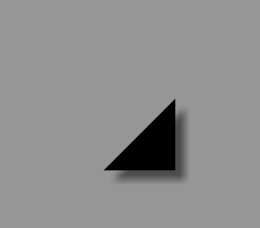
我們先來定義下vectordrawable.xml :
<vector xmlns:android="http://schemas.android.com/apk/res/android"
android:height="64dp"
android:width="64dp"
android:viewportHeight="600"
android:viewportWidth="600" >
<group
android:name="rotationGroup"
android:pivotX="300.0"
android:pivotY="300.0"
android:rotation="45.0" >
<path
android:name="v"
android:fillColor="#000000"
android:pathData="M300,70 l 0,-70 70,70 0,0 -70,70z" />
</group>
</vector>
基本結構就是這樣,我們可以看到他有兩個寬高度描述, android:height和android:height支持所有的尺寸單元,一般我們用dp,它指的是矢量圖的寬高大小。android:viewportWidth和 android:viewportHeight可以理解為在64dp裡面取600個點做為坐標來繪制下面的圖形。然後我們可以看到<group>標簽,它主要是為下面path繪制的整體部分進行一些操作,比如這裡的以軸心(300,300)對它逆時針偏移45度,或者可以通過<group>標簽name屬性來對它進行動畫操作等等。android:pivotX和android:pivotY指的就是軸心x,y軸。有了外面的整體結構,接下來就是通過<path> 標簽進行整體的繪制命令。首先是path的名字,有了這個名字我們就可以指向哪個path動畫。android:fillColor指的是封閉圖形塊具體的顏色。然後android:pathData指的就是一些繪制命令。結合下面圖來學習繪制命令:
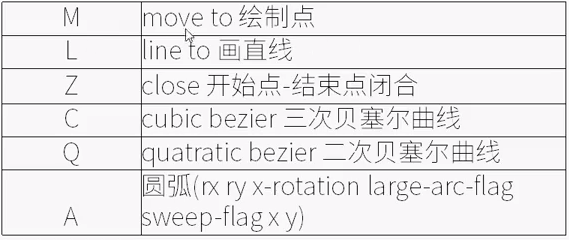
大寫絕對小寫相對參數加逗號,和canvas繪制差不多。解釋下最後一個A, rx和ry指的是以(x,y)為軸心的x軸和y軸的半徑,x-rotation指的是x軸旋轉角度,large-arc-flag 為0時表示取小弧度,1時取大弧度,sweep-flag 0取逆時針方向,1取順時針方向 。結合下面圖來理解
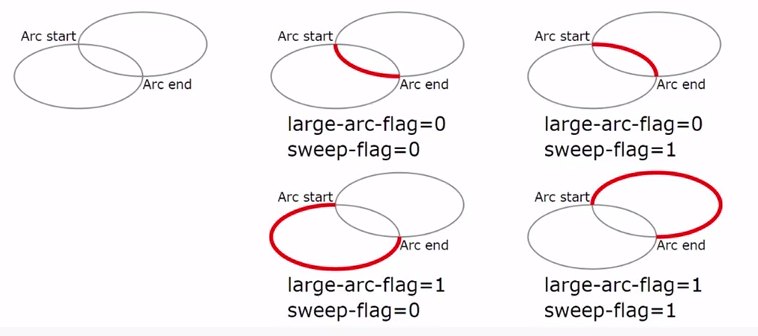
這裡以large-arc-flag=0,sweep-flag=0來寫一個path看看真正效果: 代碼如下:
<path
android:name="v"
android:strokeColor="#000000"
android:strokeWidth="2"
android:pathData="A 10 10 0 0 0 100 200"
/>
產生的效果圖:
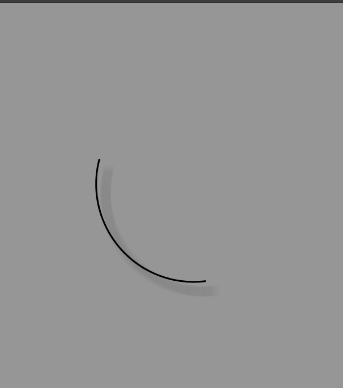
是和上面說的一樣吧!
2. 畫一個心型,如下圖。
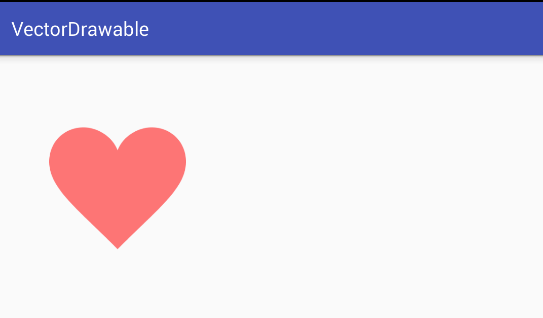
代碼如下:
<?xml version="1.0" encoding="utf-8"?>
<vector xmlns:android="http://schemas.android.com/apk/res/android"
android:height="256dp"
android:width="256dp"
android:viewportWidth="32"
android:viewportHeight="32">
<!-- draw a path -->
<path android:fillColor="#8fff"
android:pathData="M20.5,9.5
c-1.955,0,-3.83,1.268,-4.5,3
c-0.67,-1.732,-2.547,-3,-4.5,-3
C8.957,9.5,7,11.432,7,14
c0,3.53,3.793,6.257,9,11.5
c5.207,-5.242,9,-7.97,9,-11.5
C25,11.432,23.043,9.5,20.5,9.5z" />
</vector>
和上面類似,主要是android:pathData改變了。從(20.5,9.5)開始,然後就是後面畫貝塞爾曲線,相對起點水平左移1.955,垂直不移動確定一個點,然後相對起點水平左移動-3.83,垂直往下移動1.268確定一個點,再相對起點水平左移4.5,垂直往下移動3確定一個點,通過這三個點畫貝塞爾曲線,往下的類似原理。
ps: 一些簡單的命令我們是知道了,那麼svg這麼多命令,android裡面這麼多icon,總不能讓自己畫吧,我們怎麼去學習這些命令,去畫這些icon呢。還好學習命令我們可以用android:path規則 ,畫icon的pathData數據 。這樣我們就可以畫出自己想要的數據來了。
怎麼用在ImageView的背景上面呢?很簡單,來看下面的代碼:
activity_main.xml
<?xml version="1.0" encoding="utf-8"?>
<LinearLayout xmlns:android="http://schemas.android.com/apk/res/android"
android:layout_width="match_parent"
android:layout_height="match_parent"
xmlns:app="http://schemas.android.com/apk/res-auto">
<ImageView
android:layout_width="wrap_content"
android:layout_height="wrap_content"
app:srcCompat="@drawable/vectordrawable" />
</LinearLayout>
這樣效果是不是可以看到了呢,運行下,效果如上面心型,然後試著去改下他的大小,其實他不會變形的。
矢量圖動畫AnimatedVectorDrawable
我們還是以官網demo來測試。
新建一個xml文件vector_drawable.xml,放在drawable裡面,代碼如下:
<vector xmlns:android="http://schemas.android.com/apk/res/android"
android:height="64dp"
android:width="64dp"
android:viewportHeight="600"
android:viewportWidth="600" >
<group
android:name="rotationGroup"
android:pivotX="300.0"
android:pivotY="300.0"
android:rotation="45.0" >
<path
android:name="v"
android:fillColor="#000000"
android:pathData="M300,70 l 0,-70 70,70 0,0 -70,70z" />
</group>
</vector>
然後新建一個xml文件vector_drawable_anim.xml,由於AnimatedVectorDrawable在support:appcompat-v7:23.3兼容到android L(5.0)以上。所以我們放置在drawable-v21文件夾下,代碼如下:
<animated-vector xmlns:android="http://schemas.android.com/apk/res/android"
android:drawable="@drawable/vector_drawable" >
<target
android:name="rotationGroup"
android:animation="@anim/rotation" />
<target
android:name="v"
android:animation="@anim/path_morph" />
</animated-vector>
這裡我們需要指定一個android:drawable,指向vector_drawable_anim.xml文件,然後根據group的name或者path的name進行動畫設置。指定的動畫分別為rotation和path_morph
新建rotation和path_morph兩個動畫放置在anim文件夾下,代碼如下:
rotation.xml
<?xml version="1.0" encoding="utf-8"?>
<set xmlns:android="http://schemas.android.com/apk/res/android">
<objectAnimator
android:duration="6000"
android:propertyName="rotation"
android:valueFrom="0"
android:valueTo="360" />
</set>
path_morph.xml
<?xml version="1.0" encoding="utf-8"?>
<set xmlns:android="http://schemas.android.com/apk/res/android">
<objectAnimator
android:duration="3000"
android:propertyName="pathData"
android:valueFrom="M300,70 l 0,-70 70,70 0,0 -70,70z"
android:valueTo="M300,70 l 0,-70 70,0 0,140 -70,0 z"
android:valueType="pathType"/>
</set>
然後是5.0以下activity_main.xml,放置在layout下:
<LinearLayout xmlns:android="http://schemas.android.com/apk/res/android"
android:layout_width="match_parent"
android:layout_height="match_parent"
xmlns:app="http://schemas.android.com/apk/res-auto">
<ImageView
android:id="@+id/image_view"
android:layout_width="400dp"
android:layout_height="400dp"
app:srcCompat="@drawable/vector_drawable"/>
</LinearLayout>
然後是5.0以上activity_main.xml,放置在layout-v21文件夾下:
<?xml version="1.0" encoding="utf-8"?>
<LinearLayout xmlns:android="http://schemas.android.com/apk/res/android"
android:layout_width="match_parent"
android:layout_height="match_parent"
xmlns:app="http://schemas.android.com/apk/res-auto">
<ImageView
android:id="@+id/image_view"
android:layout_width="400dp"
android:layout_height="400dp"
app:srcCompat="@drawable/vector_drawable_anim" />
</LinearLayout>
最後MainActivity添加代碼:
ImageView imageView = (ImageView) findViewById(R.id.image_view);
Drawable drawable = imageView.getDrawable();
//AnimatedVectorDrawableCompat實現了Animatable接口
if (drawable instanceof Animatable){
((Animatable) drawable).start();
}
然後我們運行在5.0以下是不帶動畫效果的。效果和上面三角形效果圖一樣,這裡我們看下5.0以上的效果:
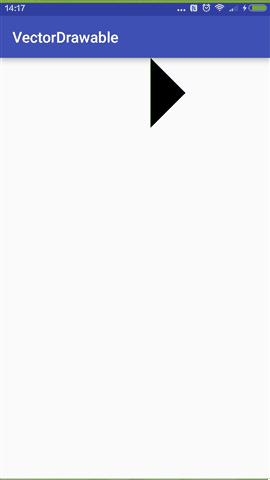
這樣我們就實現了簡單的動畫。
參考文章:如何玩轉Android矢量圖VectorDrawable
源碼下砸:VectorDrawable類自由填充色彩
以上就是本文的全部內容,希望對大家學習Android軟件編程有所幫助
 Android 5.0中的CoordinatorLayout使用技巧
Android 5.0中的CoordinatorLayout使用技巧
CoordinatorLayout 實現了多種Material Design中提到的滾動效果。目前這個框架提供了幾種不用寫動畫代碼就能工作的方法,這些效果包括:*讓浮動操
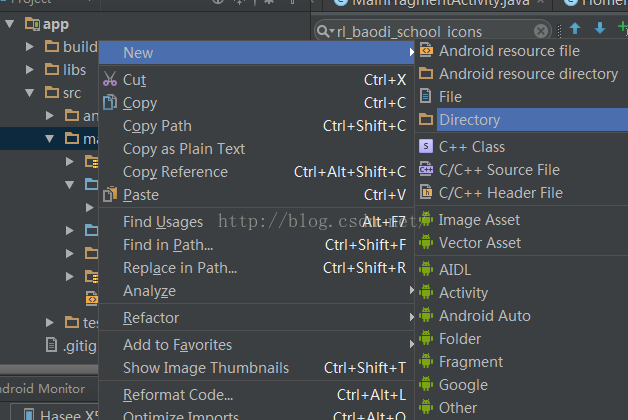 GreenDAO簡介
GreenDAO簡介
Android本身自帶的SQLite,大家一定都用過,然而在使用它時,我們往往需要做許多額外的工作,像編寫 SQL 語句與解析查詢結果等。所以,適用於 Android 的
 解決Virtualbox虛擬機下Android x86 4.0聯網問題
解決Virtualbox虛擬機下Android x86 4.0聯網問題
自Android x86出來後,很多人開始在虛擬機上安裝繼續體驗,但是安裝並不是很簡單,隨之網上各種安裝教程就出現了,Virtualbox虛擬機下Andro
 Android使用RecyclerView實現自定義列表、點擊事件以及下拉刷新
Android使用RecyclerView實現自定義列表、點擊事件以及下拉刷新
Android使用RecyclerView1. 什麼是RecyclerViewRecyclerView 是 Android-support-v7-21 版本中新增的一個